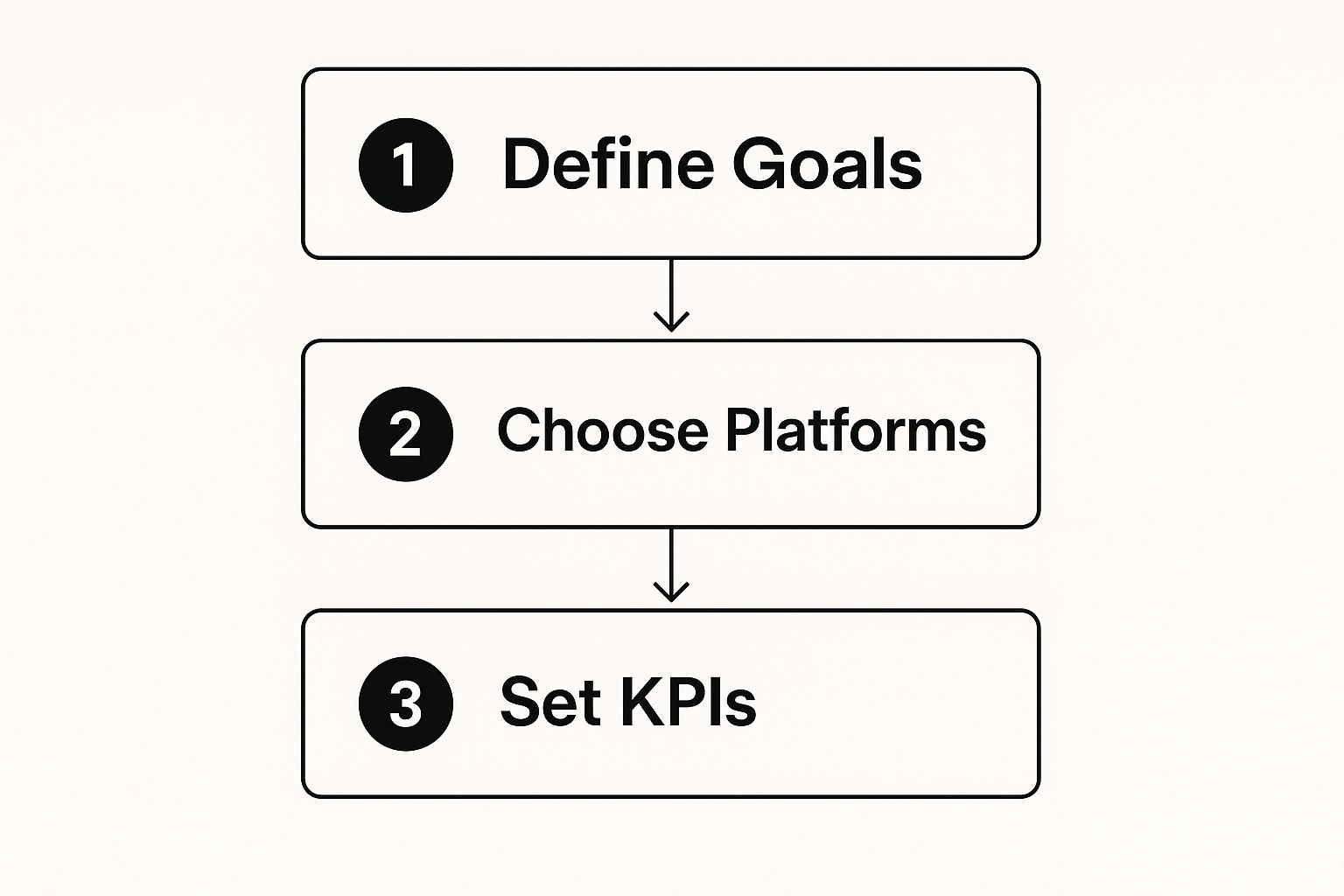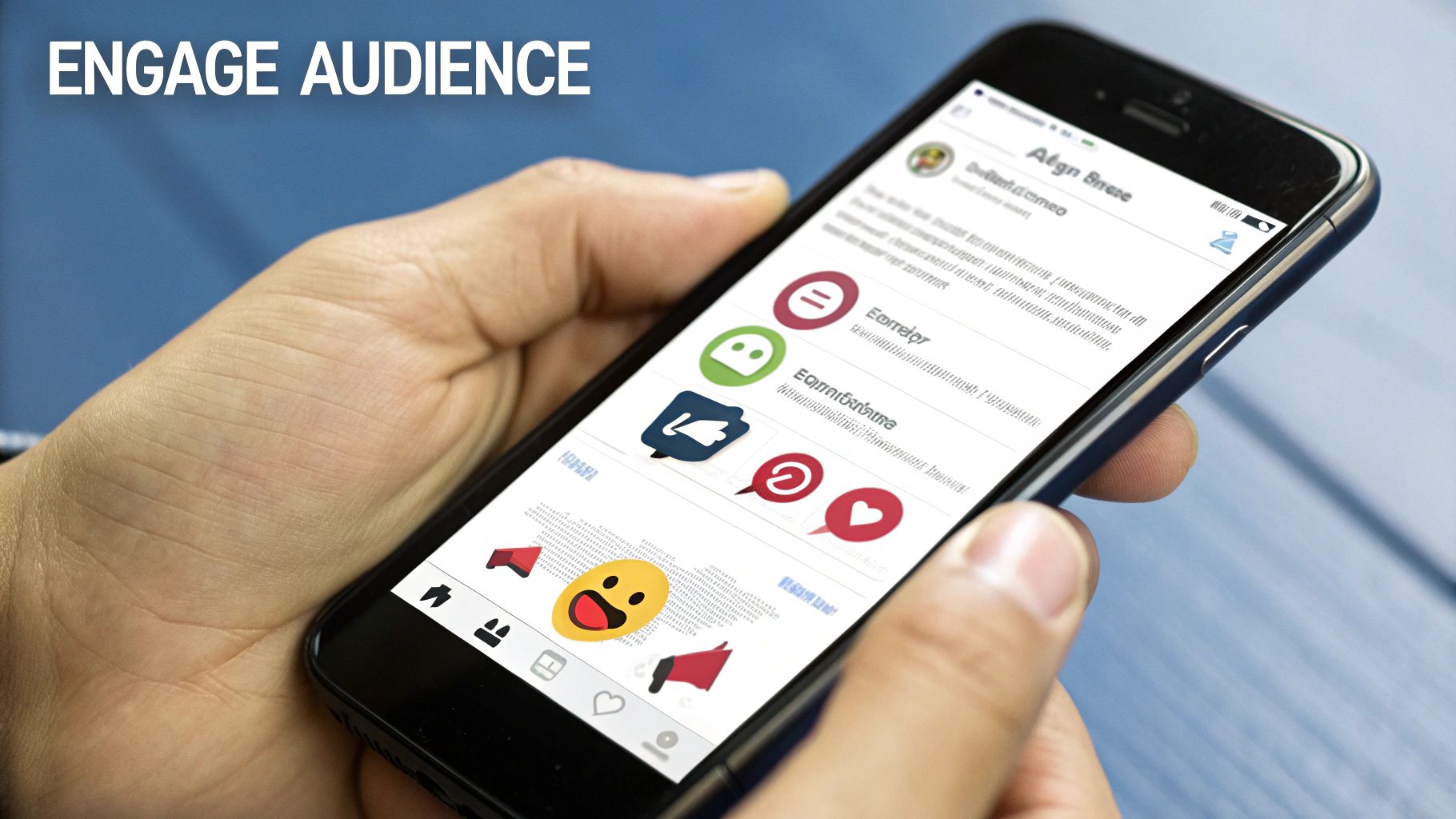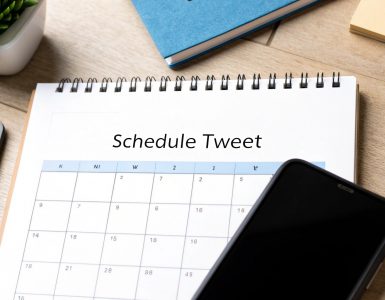A truly effective social media management workflow isn't just a to-do list. It's a living, breathing system designed for consistent growth and, just as importantly, to save your sanity. I like to think of it less as a linear checklist and more as a flywheel—each part fuels the next, turning what feels like random posting into a dependable machine for building your brand.
From a Simple Checklist to a Strategic Flywheel
Let's get one thing straight: if your social media "strategy" is just a series of disconnected tasks, you're working too hard for too little return. A real workflow is an interconnected loop. You plan, you create, you publish, you engage with your community, and then you analyze what worked. This cycle is what transforms your social media from a reactive chore into a proactive growth engine.
For a great real-world example of how these principles apply in a specific niche, this social media marketing guide for beauty salons offers some fantastic context that really brings these workflow concepts to life.
The Continuous Loop of Social Media Management
At its heart, a solid workflow is a cycle designed to keep your brand visible and relevant. It’s all about smart audience interaction and using data to make your next move even better. A 2025 Sprinklr report highlighted that engagement is a massive driver of content reach. Think about it: valuable content sparks engagement, and the algorithms reward that engagement by showing your content to more people. It's a self-perpetuating loop.
A workflow that doesn't evolve is a workflow that will eventually fail. The goal is to create a system where insights from your analytics directly inform your next round of content planning, ensuring continuous improvement.
This whole process starts with a solid foundation. You have to define your goals, pick the right platforms for your audience, and set clear KPIs to measure success.

Without these initial strategic decisions, everything that follows—from the content you create to the reports you pull—lacks direction. Getting this right is the bedrock of your entire workflow.
Mapping the 5 Core Phases of a Social Media Workflow
So, what does this flywheel actually look like in practice? I've found it helps to break it down into five core phases. Each stage has its own distinct purpose, but they all flow into one another, creating that momentum we're after. Understanding how they connect is the first step to building a more powerful and efficient process.
This table provides a high-level blueprint of the entire cycle.
| Phase | Objective | Key Activities |
|---|---|---|
| Plan | Establish clear goals and a strategic direction. | Define content pillars, identify target audience, set KPIs, conduct competitor analysis. |
| Create | Develop high-quality, relevant content consistently. | Brainstorm ideas, write copy, design visuals, record videos, manage editorial calendar. |
| Publish | Distribute content effectively across chosen platforms. | Schedule posts, use automation tools like EvergreenFeed, optimize for peak times. |
| Engage | Foster a community and build relationships. | Respond to comments/DMs, monitor brand mentions, participate in relevant conversations. |
| Analyze | Measure performance and gather actionable insights. | Track key metrics, review analytics dashboards, generate reports, identify trends. |
Seeing these phases laid out makes it clear how each one sets up the next for success. Your analysis of past performance directly feeds back into your planning phase, starting the cycle all over again, but this time, you're smarter.
Building Your Content Creation Engine

Let's be honest: a great social media presence isn't built on random bursts of inspiration. If you're constantly scrambling for what to post next, you're already behind. This leads to inconsistent, often lower-quality content that doesn't do your brand any favors.
The secret is to stop thinking like a content creator and start thinking like an engineer. You need to build a content creation engine—a system that reliably produces a steady stream of valuable posts that actually align with your business goals.
It all begins with defining your content pillars. Think of these as the 3-5 core topics your brand owns. They should be broad enough to spark endless ideas but specific enough to attract the right people. For a financial advisor, these pillars might be "Retirement Planning," "Investing for Beginners," and "Wealth Management."
These pillars are your guardrails. They keep you focused and prevent you from chasing every shiny new trend that doesn't serve your long-term strategy.
Structuring Your Content Mix
One of the quickest ways to lose your audience is by posting the same type of content over and over, especially if it's all self-promotional. To keep people engaged, you absolutely need variety. A balanced mix of original and curated content is what keeps your feed fresh and positions you as an expert, not just another brand trying to sell something.
After years of fine-tuning, I've found a healthy content ratio that works wonders:
- Original Content (60%): This is your brand's unique voice in action. It's the content you create from scratch—snippets from your blog, behind-the-scenes videos, customer stories, and custom graphics. This is where your personality shines.
- Curated Content (30%): This is where you share relevant articles, insightful studies, or great posts from other respected voices in your industry. The key here is to always add your own two cents. A simple "Here's what I think about this…" provides context and showcases your expertise.
- Promotional Content (10%): These are your direct asks, your calls-to-action for products or services. By keeping this to a small fraction of your posts, you earn the right to sell because you've spent the other 90% of the time providing genuine value.
A great content creation engine doesn't just produce more content; it produces the right content with less effort. The goal is to systematize idea generation and asset creation so you can focus on quality and consistency.
This structured approach is a powerful combination. Curated content builds your credibility, original content builds your brand, and promotional content drives the business forward. It's the backbone of a strong social media management workflow.
Implementing Practical Creation Strategies
With your pillars and content mix figured out, it's time to get practical. Two habits have made the biggest difference in my own workflow: content batching and building a reusable asset library.
Content batching is a game-changer. Instead of the daily grind of creating a post, you block off a chunk of time to create content in bulk. For example, you might dedicate four hours every other Monday to create all your posts for the next two weeks. It's a simple shift, but it dramatically reduces the mental drag of switching tasks and skyrockets productivity.
At the same time, you should be building a reusable asset library in a shared drive or a dedicated content tool. This isn't just a folder of random images; it's a strategic resource. Your library should include:
- Branded templates for different post types (quotes, tips, announcements).
- A go-to folder of high-quality photos and approved stock images.
- Official logos and brand graphics in various formats.
- A simple document with pre-approved hashtags and calls-to-action.
This library instantly ends the daily scramble for visuals and ensures every post looks and feels like it came from your brand. When you combine content batching with a well-stocked asset library, you transform content creation from a chaotic daily chore into a predictable, manageable system.
How to Automate Your Publishing and Scheduling

This is where you get your time back. Seriously. If you’re still manually posting every single update, you’re not just being inefficient—you're actively holding back your own growth. A smart social media management workflow leans on automation to do the heavy lifting, giving you the freedom to focus on what actually matters: talking to your audience and figuring out what’s working.
The idea isn't to just "set it and forget it." It’s about building a dependable system, especially for your evergreen content. This keeps your profiles buzzing with valuable information even when you're busy with a product launch or, you know, taking a vacation. The right tool is the engine that drives this entire phase.
Selecting the Right Scheduling Tools
The world of social media schedulers is packed with options, but only a few key features truly make a difference in a real-world workflow. Don't just grab the first one you find; look for tools that solve your specific problems.
Let’s say you’re a small business running the Instagram, Facebook, and Pinterest for a local coffee shop. You need more than a basic scheduler. You need a tool that lets you tweak the same post for each platform from one screen. In a single click, you should be able to shorten the text for Instagram, pop in some relevant hashtags for Pinterest, and tag a local business partner on Facebook. That’s real efficiency.
The real win with scheduling automation isn't just saving a few minutes on posting. It's the power to strategically drop your best content in front of your audience at the perfect time, over and over again. This turns publishing from a daily chore into a strategic advantage.
When you're comparing tools, these are the non-negotiable features you should be looking for:
- Platform-Specific Customization: The ability to tailor a single post for different networks is a must. It’s the difference between looking smart and looking like a robot that just cross-posts everywhere.
- Best Time to Post Suggestions: Good tools analyze your audience data and suggest the optimal times to post, giving your content the best possible chance for initial engagement.
- Evergreen Content Recycling: This is where tools like EvergreenFeed shine. They let you build libraries of your best, timeless content that gets re-shared automatically, keeping your feeds alive with proven winners.
- Visual Calendar and Approval Flows: Seeing your entire month's content laid out on a calendar is crucial. It’s essential for spotting gaps and, if you have a team, for making sure everyone is on the same page before something goes live.
From Posting to Connecting
Think about how your morning could change. Instead of scrambling to figure out what to post across three different platforms, you could spend that first hour of your day replying to comments and DMs from yesterday's scheduled posts. That’s the real-world impact of automating your publishing.
When you batch-schedule your core content a month ahead, your daily role shifts completely. You stop being a content publisher and start being a community manager and a strategist. This is the transition that separates brands that just broadcast from those that build genuine communities.
For a more detailed walkthrough on getting these systems up and running, our complete social media automation guide covers it all. Making this shift is what will ultimately lead to real, sustainable growth.
Using AI as Your Strategic Partner

When most people think about AI in social media, their minds jump straight to writing captions. And sure, it's a neat party trick. But using AI just for content generation is like owning a sports car and never taking it out of first gear. The real magic happens when you stop treating AI as a simple tool and start thinking of it as a strategic partner in your social media management workflow.
Imagine having a data-obsessed analyst on your team who works 24/7. This partner can tirelessly sift through mountains of data to flag emerging trends before they go viral, giving you a huge first-mover advantage. It can analyze the sentiment behind thousands of brand mentions, giving you an honest, real-time pulse check on your reputation.
This isn't just a futuristic idea—it's already happening. A 2025 Hootsuite survey of nearly 4,000 social media pros revealed a surprising insight: AI adoption is actually higher among high-level strategists than among those in execution-focused roles. You can dig into the full findings on AI usage in social media strategy from Hootsuite to see the data for yourself.
From Task Automation to Strategic Insight
Moving AI into a strategic role is all about changing the questions you ask. Instead of asking, "Write me a post about our new product," you start asking bigger, more foundational questions that can shape your entire content plan. This shift fundamentally changes your workflow from reactive to proactive.
Think of AI as your 'thought partner' for high-level brainstorming sessions. You can feed it your best-performing posts and your top competitor's content, then ask it to identify thematic gaps or new content pillars you haven't considered. This doesn't replace your creativity; it amplifies it by pointing you in more fruitful directions.
Here are a few ways I’ve seen this work in practice:
- Competitor Deep Dives: Ask an AI tool to summarize a competitor's social media strategy from the last 90 days. It can pinpoint their core themes, posting cadence, and most successful content formats, delivering in minutes insights that used to take my team hours of manual research.
- Real-Time Audience Sentiment: Use an AI-powered listening tool to monitor brand conversations. Are people frustrated with a recent app update? Are they raving about a new feature? This gives you an immediate feedback loop that can inform not just your content, but your product development too.
- Smarter Data Analysis: Instead of just staring at a dashboard of metrics, feed that performance data to an AI and ask, "Based on this data, what are three actionable insights for next month's content plan?"
The most effective social media managers aren't being replaced by AI; they're the ones learning how to command it. The goal is to make smarter, data-backed decisions that make your creative work even more impactful.
This screenshot from the Hootsuite research perfectly illustrates the divide.

The key takeaway here is clear: senior strategists are leaning on AI for high-level planning and analysis, while others are more focused on using it for individual tasks.
Making AI-Powered Decisions with Agility
Ultimately, integrating AI as a strategic partner makes your entire operation more agile. When a new trend explodes overnight, you can use AI to instantly analyze its relevance to your brand and brainstorm authentic ways to join the conversation without looking like you're trying too hard.
If a campaign is underperforming, AI can help you diagnose the "why" much faster by cross-referencing performance data with audience sentiment and competitor activity. This allows you to pivot your strategy with more confidence and precision, ensuring your social media efforts are always moving in the right direction.
How to Measure and Optimize Your Workflow
Let's be honest: a social media workflow is never truly "finished." It's a living, breathing process. The platforms change on a dime, your audience's preferences shift, and your own business goals will naturally evolve. If your workflow doesn't adapt, it's just not going to work long-term.
This final part of the puzzle is all about closing the loop. We're going to dig into how to measure what actually matters and use that information to make your entire system smarter, faster, and more effective. It's time to move past feel-good numbers like likes and follower counts. They're nice, but they don't tell the whole story or prove value to your boss or client.
The real goal is to connect your hard work on social media to tangible business results and prove its return on investment (ROI).
Focusing on What Truly Matters
The pressure to show real value from social media is on. Measuring its ROI is still a major challenge for most teams. According to the 2025 Sprout Social Index, a solid 65% of marketing leaders expect to see a direct line from social media campaigns to business goals. Yet, only 30% of marketers feel they can actually measure it accurately.
This is a huge disconnect, especially when you consider that 81% of consumers say social media has influenced their spontaneous buying decisions. The audience is there and ready to act; we just need to get better at tracking it.
To do that, you have to focus on metrics that tell a business story. These are the numbers that justify budgets and get your stakeholders to lean in.
- Lead Generation: How many people actually filled out a contact form after clicking a link in your post? Did they download that PDF you offered?
- Website Traffic: Look at your analytics. What percentage of your website's referral traffic is coming from social? More importantly, which specific posts are sending the most qualified visitors your way?
- Conversion Rate: Of all the people who landed on your site from social media, how many took that next step? Did they make a purchase, sign up for your newsletter, or start a free trial?
Getting a handle on these deeper metrics is the foundation of proving your worth. For a full breakdown of this process, our guide on how to measure social media ROI walks you through the entire framework for connecting social activity to revenue.
Conducting a Quarterly Workflow Audit
Having data is one thing; acting on it is another. The best way I've found to keep a workflow sharp is to schedule a dedicated quarterly audit. This isn't just about glancing at a dashboard. It's a focused session where you and your team ask the tough questions to find real opportunities for improvement.
An audit isn't about finding what's broken or who's to blame. It's about finding opportunities. The goal is to spot the bottlenecks and double down on what’s working so your process becomes more efficient every single quarter.
Think of it as a strategic tune-up for your social media engine. Block out a few hours every three months to review the entire system, from content planning all the way to analysis.
Critical Questions for Your Workflow Audit
| Category | Key Question to Ask | Why It Matters |
|---|---|---|
| Content Performance | Which content pillars and formats are actually driving engagement and conversions? | This tells you where to put your creative energy. Stop wasting time on content that falls flat. |
| Process Efficiency | Where are we losing the most time? What are the biggest bottlenecks in our creation and approval process? | Finding these friction points is the first step. You can then solve them with a better tool or a simple process tweak. |
| Tool Effectiveness | Is our current tech stack (scheduler, analytics tools, etc.) truly saving us time and giving us clear insights? | A tool that's clunky or doesn't deliver the right data is a liability, not an asset. Don't be afraid to switch. |
| Goal Alignment | Is our day-to-day social media activity still directly supporting our main business objectives? | It’s surprisingly easy to drift off course. This question pulls your focus back to what moves the needle for the business. |
When you answer these questions honestly, you create a clear, actionable roadmap for the next 90 days. It ensures your social media management workflow doesn't just run on autopilot—it evolves, improves, and consistently delivers the results you were hired to achieve.
Answering Your Top Questions About Social Media Workflows
As you start piecing together a more organized system for your social media, a few questions always pop up. It's totally normal. Building a great social media management workflow is all about tweaking and refining things over time, not getting it perfect right out of the gate.
Let's clear up some of the most common hurdles I see people face.
One of the first things people ask is what separates a workflow from a strategy. It's a great question. Think of it like planning a big road trip:
Your strategy is the destination and the "why." For instance, "We're going to use Instagram to connect with young professionals and make our brand a household name for them."
Your workflow is the turn-by-turn navigation—the "how" you'll actually get there. This looks more like, "We'll batch-create all our content on Mondays, get it scheduled out on Tuesdays, and then dig into the analytics every Friday morning." They're two different things, but one can't succeed without the other.
Can a Solo Entrepreneur Really Do This?
Not only can you, but you almost have to. When you're a one-person show, a solid workflow is your secret weapon against burnout.
The trick is to start small and build from there. Don't get overwhelmed trying to create a massive, corporate-level system on day one. Pinpoint your biggest time-drains and tackle those first. For most solo founders, automating the publishing schedule is a game-changer. Even just a basic content calendar in a spreadsheet and a free scheduling tool can free up a surprising number of hours every single week.
A solo entrepreneur benefits most from a workflow because it forces prioritization. You can't do everything, so a good system ensures you're consistently doing the right things that have the biggest impact.
How Often Should I Revisit My Workflow?
A workflow isn't a "set it and forget it" kind of deal. The best ones are living, breathing systems that you adapt as you learn what's working.
I recommend a light check-in monthly and a full-blown audit quarterly.
-
Monthly Check-in: This is a quick pulse check. How's your content performing? Are your posts still hitting those sweet spots for engagement? Is your scheduling process feeling smooth or clunky?
-
Quarterly Audit: Time for a deeper look. Step back and re-evaluate your big-picture goals. Are the content pillars you chose still making sense for your business? Is it time to swap out a tool in your tech stack?
This regular rhythm keeps your workflow from getting stale and ensures it's always pulling its weight. This is a key part of the larger strategic process, much like we detail in our guide on how to create a social media plan. By constantly asking these questions, you make sure your efforts get smarter and more effective over time.
Ready to put your workflow on autopilot and save hours every week? EvergreenFeed automates your evergreen content scheduling so you can focus on growth. Start for free and see the difference.




